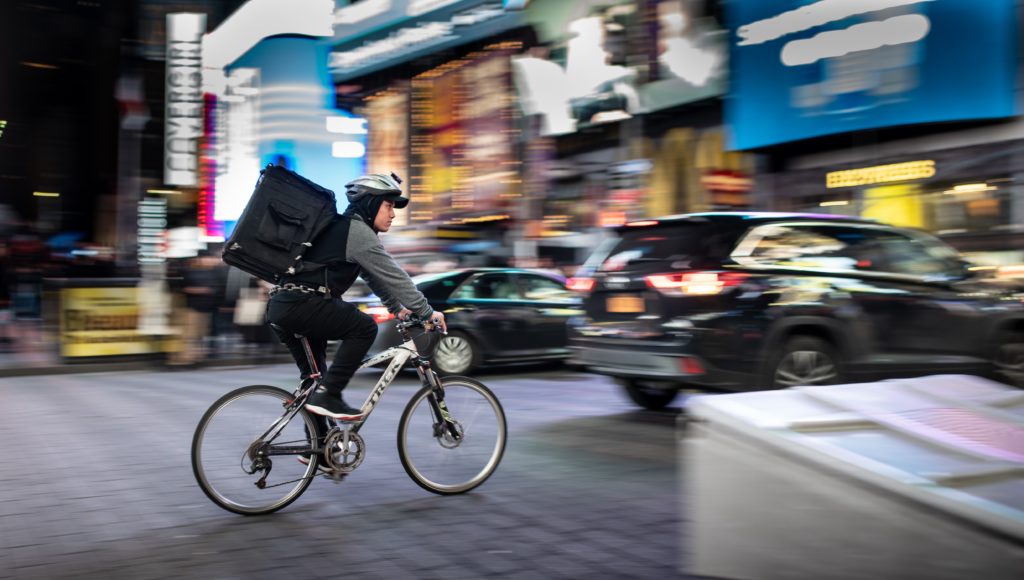
Quick-commerce : définition et enjeux logistiques
When a consumer makes an order online, they expect delivery times to be always shorter. Delivery is also one of the main criteria for dissatisfaction in e-commerce. It is to this demand that young French and European start-ups want to respond. They offer ultra-fast delivery, usually in less than thirty minutes. This trend is called quick commerce (or q-commerce). This is a real challenge in terms of logistics and technology. The risk is great, because if the promise is not kept, the whole business model is called into question. Their meteoric growth, however, proves that consumers are responding positively to this ever faster delivery service. It is therefore an entire distribution system that must rethink and integrate the logistical issues posed by this fundamental trend.
Quick Commerce: Definition
Since the first lockdown linked to the Covid-19 pandemic, home deliveries have multiplied. The growing demand, for all types of goods, has allowed quick commerce to also experience a meteoric rise. In 2020, companies specializing in Quick Commerce delivered nearly nine million orders in twenty-two countries.
Quick commerce, or q-commerce, is part of the logical continuation of online commerce. This consists in delivering to the final customer an order that he has made at the latest one hour before.
E-commerce offers, on average, delivery in three to five days. This may be less with some carriers, with a higher delivery package. The q-commerce offers a delay that is counted not in days, but in hours, or even minutes.
Quick commerce relies more on a purchase of impulsivity,rather than thoughtful. It is not a question of shopping for the week, but of meeting an immediate need. Companies specializing in q-commerce aim to be faster than consumers themselves. Getting delivered would therefore be almost more efficient than going shopping around the corner.
This is a real revolution for large retailers,whose brands are the first threatened by q-commerce. Indeed, the start-ups now positioned on this niche offer in particular the delivery of groceries in thirty minutes to one hour.
The counterpart of this record time is to offer a more limited offer, easier to handle and transport. This last issue is crucial, because the trend of quick commerce is especially strong in large cities. To compensate for the often heavy traffic, two-wheeled vehicles are preferred. In fact, it is a parameter to take into account when defining the product catalog.
To keep its promise, q-commerce relies on a powerful application, as well as on the availability of its order preparers and delivery drivers.
The logistical challenges of Q-commerce
Quick commerce, with its business model based on ultra-fast delivery, is a real logistical challenge. It is, however, a service to which companies must adapt. Already acclaimed by consumers, this is a trend that is gaining momentum. To ensure ever faster delivery to customers, this requires logistical adaptation, on several levels.
Ensure a short delivery time
Quick commerce is based on a single promise: to deliver the customer in a very short time. In general, there is one hour or less depending on the geographical location. 80% of buyers on the Internet do not renew an order from a brand due to an unfulfilled delivery time. The value proposition of q-commerce companies is based on this single criterion.
Offer local delivery
Unlike e-commerce, q-commerce relies on a local network and not on a central warehouse. The latter, often located on the outskirts of cities are, due to their remote location, inappropriate for q-commerce logistics.
Shortening the time between the time of the order and that of delivery therefore implies a geographical proximity between the warehouse and the final customer. This presupposes an optimal management of the logistics of the « last mile » This refers to the moment between the end of the delivery process and the arrival at the destination, at the customer’s premises.
Have smaller storage spaces
To respond as quickly as possible to the demands of their customers, quick commerce companies need small storage spaces. The offers in the catalog are more limited, so the need for less space than for a classic e-commerce warehouse.
Quick commerce storage spaces are often either stores or dedicated darkstores. « Black stores » are a type of warehouse suitable for e-commerce. They have facilities similar to those frequented by consumers, but are strictly reserved for the preparation of orders. Instead of finding customers on the shelves, there are order preparers.
Prepare orders quickly
The reduced offer of quick commerce companies saves time on the preparation of orders. The faster the preparer, the more the deliveryman can take over. This suggests that the structure of the warehouse or store is thought in this logic of optimization.
Ensuring stock availability
As in e-commerce, the availability of stocks is one of the challenges of quick commerce. When the customer places an order, the product must absolutely be available for delivery, otherwise it will generate a feeling of dissatisfaction. It is the e-reputation of the company that would be compromised, while this is a fundamental point given the growing number of competitors. Inventory management must therefore be automated and inventories rigorously controlled. Technology therefore plays a central role in the success of quick commerce.
Whatever the type of products, buying online is now a well-established habit. Consumers, who are therefore accustomed to this practice, are increasingly demanding, especially when it comes to delivery. This is how the Internet, by allowing access to ever faster services, has made q-commerce a « natural » evolution of e-commerce. Companies will have to adapt and anticipate both technological and logistical issues that this generates.

